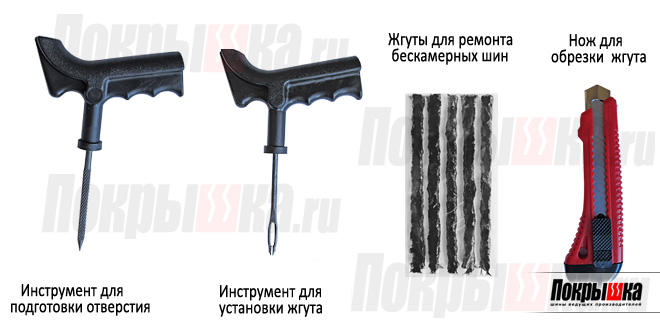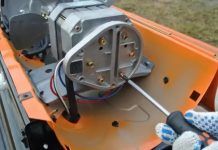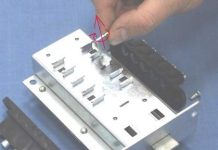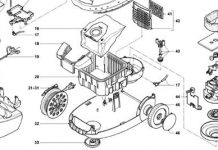The breakdown is sealed with a sealant like this: first, we remove the element that pierced the tire (if it is not visible, then you do not need to look for the hole). Next, the damaged wheel must be jacked up. Using a tube with a tip, we connect the can with the nipple. We inject all the available sealant inside the tire, after which we turn the wheel several times so that the sealant spreads evenly over the inner surface. We are waiting for a couple of minutes for the product to fill the hole and thicken, thereby clogging the existing hole.
The following self-repairs involve removing and disassembling the wheel, since the puncture is repaired from the inside. Minor damages are repaired with patches glued to the breakdown site. Medium-sized breakdowns are eliminated by "fungi". For large damages, vulcanization is already involved. These methods are often used at service stations.On the way, it is very difficult to use them due to the need to disassemble the wheel.
A small (up to 5 mm) tire puncture can be corrected by yourself. Do-it-yourself tubeless tire repair is easy. Sometimes you can even leave the wheel on the car. The main thing is to clearly follow the instructions.
Make sure the tire is tubeless before starting work. All you need is a tubeless tire repair kit. The set consists of special harnesses for repairing tires (3-4 pcs.) And two accessories: a tool for preparing a puncture for repair (file) and for installing a special cord into the hole (awl). May also include a cord cutter. Make sure the knife is sharp. The flagella from the set are reinforced with special metal fibers. A dull knife will not cut such material. A clerical knife works well. A vulcanizing compound or adhesive may also be needed.
A set for repairing tubeless tires is inexpensive - 100-500 rubles. (depends on the configuration). It makes no sense to save. Tubeless tires are made up of many layers, and there is a metal cord under the tread. The tools must be especially strong (metal and handle), it will be necessary to pierce all the hard layers and prepare a hole for the cord. It is better not to save money on tools.
The handles on the implements can be different, for example, screwdrivers. Since you need to make a lot of effort during work, it is better to find implements with wide, comfortable handles (as in the photo).
VIDEO
Find the puncture site. If there is something in there (a nail, a piece of glass, a sharp stone), remove the foreign object. It is necessary to mark the hole, otherwise it will be difficult to find later. You can use chalk or a marker. Warning! Do not repair old wheel models (with camera) using this manual. Will not help.
Clean any dirt from the puncture and measure its size. If the hole is wider than 5 mm, you have to go to the workshop. There they will install a special "fungus" at the puncture site. When there is no workshop nearby and you need to get there, you can insert 2 harnesses. This is usually not done, but in certain situations it can help.
If the harness can still be installed, lower the air pressure in the wheel to 0.5 atmosphere. It is necessary to relieve stress on the wheel structure so as not to damage the cord. Insert a file into the hole and rotate it. Your task is to design a hole enough to push the tourniquet there.
Pass one end of the tourniquet into the cut of the second tool, sew, roughly like a thread in a needle. You can coat the tourniquet with glue. Then push the awl and tourniquet into the widened puncture two-thirds. Next, carefully pull out the tool, and the tourniquet will remain inside the tire.
It is necessary to push the tourniquet into the puncture in 2 layers. The length of the bundle is very important. Most should stick out of the hole, and the smaller part should stay inside the tire in two layers. Leaving only 1 layer is incorrect, the diameter of the tool is designed for 2 layers.
Now all that remains is to inflate the wheel and check for air leakage at the puncture site. If the puncture site is still missing, repeat the entire operation again. If you did everything correctly, the tourniquet will securely close the hole and no air will escape.
Check for air release, then cut the harness from the outside so that it does not stick out. Watch out for cuts!
In addition to the ease of implementation, there is no need to do additional balancing of the wheel. The tourniquet weighs nothing.Remanufactured tubeless tires are not the most reliable. They should be driven carefully, at low speed and on a flat road. If the patched tire suddenly collapses, it will be possible to react quickly. It will be necessary to change such a protector in the near future.
As a result, making a quick repair of a tubeless tire is a snap if you follow the instructions in the article. Simple tools, proven technology and 15–20 minutes of time. Keep in mind, however, that a tire repaired in this way is not reliable. The best option is to drive such a tubeless tire to the nearest vulcanization and make a full repair.
In view of today's puncture, HERE in the evening at a gas station purchased this set for repairing tires, because experience of use already exists.
When the hole becomes larger and the awl-file walks more freely, proceed to the trail. stage.
Then I insert the liquid rubber into the needle tool and wet it again with glue
And I drive it into the hole, then I pull it out sharply and that's it, it's done)
I washed the appliances, put them back in the packaging, tomorrow I'll put them in the trunk, let him ride with me)
Well, tomorrow I will cut off the leftovers and put them in place)
Price tag: 210 ₽ Mileage: 16500 km
it should be remembered that the tourniquet is a temporary measure.
Well, what to put on for a long time?
A fungus or patch will be placed on the shank.
At many tire shops, punctures are repaired in this way ... To install a fungus or a patch, you need to remove the tire from the disk, and it's cheap and fast ...
The tourniquet is a temporary measure. can take off in 20 minutes. there is no guarantee for it.
This tourniquet is a very good thing, how many of these punctures I have never let down, and I rode on vacation, all the rules.
Well done)
I once bought such a budget set with a T-shaped handle, but using it once after installing the harness at the moment of pulling out the handle remained in my hand, the counterpart in the wheel. I don’t use this stuff anymore. I went to a store where they sell everything for repairing wheels and bought a professional fork for installing harnesses and it turned out no more than 250re. I just bought it for a long time, I don’t remember exactly. The main thing is not to fall apart! And so such a set can really save time and money!))
Today I'm on a regular wheel)
It is more convenient with a T-shaped handle, but as I understand they were not on sale?
The first car tire models came with cameras that could be easily repaired by hand. It was enough to disassemble a flat tire, use a container of water to find a hole, clean up the radius around the hole or cut, dry it, apply glue and press it for a day. This method was used not only before, but also now, for those who are used to fixing problems with their own hands. Now, because tubeless tires have taken over the market share, they are on most cars. But how do you repair a hole in a tubeless tire?
To repair tubeless tires with your own hands, you will need a puncture repair kit and tools. There are sets of kits in which, in addition to useful and necessary tools, they contain useless ones. Therefore, you can buy the parts you need to repair separately.
If, while driving, you feel that you have run over something sharp and punctured the wheel, then you should not immediately pull out this nail, wire, self-tapping screw, etc. You have to stop, get out and see how badly the tire is damaged. If a nail or something that is stuck there, then let it sit there, in this position you can pump up the wheel to get to the house or to the place of repair. If you notice that the wheels are braked unevenly, one wheel grips earlier, then perhaps it's time to change the brake pads. Replacing the rear and replacing the front brake pads with your own hands is also possible to do.
Due to the composition of the rubber and the construction of the tire, the presence of a foreign object in the cord, the rubber completely envelops the object and almost does not allow air to pass through. A cousin once said that he had been driving with a self-tapping screw in a tubeless tire for about a year. Although it is possible to drive with such a problematic wheel, it is better to fix the problem right away.
If the steering wheel suddenly began to beat, then this may be one of the signs of a malfunction of the steering rack.
In the event of a puncture, it is possible that the wheel is deflated very quickly. In this case, you can temporarily repair the tubeless in two ways:
Using a tourniquet or patch.
With the use of a sealant.
Special harnesses for sealing a puncture of a tubeless tire are also different:
cord harnesses;
rubber bands;
anchor harnesses.
This harness is the most common way to repair tubeless tires in the field. Composition of the cord: a strip of nylon which is impregnated with glue made of rubber.
Installation of such a bundle is done with two awls: spiral and installation. A spiral awl is needed in order to pierce the puncture site with it. With the help of it, the tire is turned out and cleaned of dirt. And with the second, an installation awl, a harness is inserted into the already cleaned and expanded place. After inserting the harness, the first spiral bus must be pulled out, and the adjusting awl together with the harness must be pushed even deeper. Then, the second awl is also pushed out, and the tourniquet remains. The tourniquet will stick out of the cut in the tire. The protruding part of the bundle must be cut off.
Did you know that there are chains and anti-skid bracelets. The difference between chains and anti-skid bracelets is that, in order to put on the bracelets, you do not need to raise the car with a jack.
In terms of quality, rubber is better than cord. And the price of the rubber harness is higher. The principle of operation with such a harness is slightly different.
When working with a rubber harness, do not use an awl-rasp, because it can damage the material of the harness during installation in the tire.
Before installing the harness, it must be greased with glue, preferably recommended by the manufacturer of the harness.
There is a tourniquet that has a patch at the end in the form of an anchor. The principle of installing such a bundle is similar to the previous ones. This harness clogs the hole and is glued to it from the inside with a patch. In order for it to stick, it is necessary, after the tourniquet is inserted, to pull back a little.
To carry out such works on sealing tires, you need to buy a 6 mm milling cutter for inserting an anchor. Using an anchor harness is the safest way to repair tubeless tires.
None of the harness types are used to repair tubeless tires. Do-it-yourself puncture repair is a temporary troubleshooting. If you plan to use the car for a long distance, then it is better to go to a tire changer and do it efficiently. If the rubber cannot be repaired, you will have to buy a new one. To choose the right rubber, you need to learn how to decipher the speed and load indices of tires.
Applying tubeless sealant is the fastest and most popular way to keep you on the move in minutes.
The item that pierced the tire does not need to be pulled out. Connect the tubeless sealant bottle and pump the contents of the tube into the wheel.
In ancient times, there was GOST 5170-73 "First aid kits for the repair of pneumatic tires." What components were not in these first-aid kits! And the fungus, and the grater with the plaster, and the roller ... And now each manufacturer decides for himself what to put in his set.
Let's check what the descendants of those travel first aid kits are capable of. The editorial office of Grant pushed for decisive action, one of the wheels of which expired. Instead of a tire service, we visited several shops where we purchased 16 different tubeless tire repair kits. The range of prices is sevenfold, although the principle of operation is the same.After detecting a puncture, you need to remove the culprit of the trouble (self-tapping screw, nail), then widen the hole and tightly insert the folded rubber flagellum into it. The nuances of technology and tools may vary, but in general, the repair algorithm is just that.
Having repaired the tire, which met a self-tapping screw on the road, we decided to test all 16 repair kits on the poor thing. However, in the end, only 13 stabbing wounds were inflicted on her, since three sets were rejected at once: the flagella in them are frankly bad, instantly tearing in their hands.
The tools also vary quite a bit. So, the nice handle in the CityUp CA-793 set managed to turn against the tip at the very first attempt to get inside the tire.
Note that in some kits, no "picks" are provided, and in some places there is no glue. And the names of the tools are different for almost all manufacturers - in the explanations we give exactly the "proprietary" version.
A tire with so many holes in the tread has passed the test at speeds of over a hundred for a couple of weeks without losing a drop of precious air. For the sake of experiment, we didn't even cut a few ponytails - and we all resisted. A small puncture in the sidewall was also managed with the help of a flagellum. Although the reliability of sealing is noticeably lower than in the case when the harness is kept in a thick (even for a worn tire) tread layer.
At the close of the curtain, another test was carried out - a kind of "everyday" test: they pierced the sidewall of the tire, like some bully with a knife or a screwdriver. We were no longer engaged in comparative tests, but simply fought for survivability. By the way, the same damage occurs, for example, when the tire contacts the curb or the sharp edge of the pit. Such a temporary repair is a priori more difficult: the sidewall is thinner than the tread, and therefore it is more difficult for the flagellum to stay in the hole.
Equipment: spiral awl, harness installation tool, raw rubber strips (5 pieces),
The spiral awl destroys the cord - when installing, you can hear the cracking of breaking threads. However, the repaired wheel runs successfully.
Equipment: tool for stripping and forming a hole, an awl with an eyelet, reinforced cords (5 pieces), glue
The beautiful handle of the rasp immediately turned - the set can be removed from the test. Okay, we took an analogue of the "pick" from another set ... As a result, the wheel was repaired, but one cannot help advising to purchase such a first-aid kit.
Equipment: twisted tip tool, eye tool, wet rubber activator, wet rubber strips (8 pieces), cutter
The spiral awl is good, the handles are comfortable. Note the presence of a cutter in the kit - in other kits it is not. I liked the first aid kit, but a little expensive.
Equipment: tool with twisted tip, tool with eyelet, glue-activator for raw rubber, rubber cords (3 pieces)
I didn’t like the picker: it was tearing the cord. But the wheel was still repaired.
Equipment: tool with twisted tip, tool with eyelet, glue-activator for wet rubber, harnesses (5 pieces)
A tool with a hole such as the eye of a needle has a groove too wide. Nevertheless, the kit passed the test.
Equipment: a tool for stripping and forming a hole, an awl with an eyelet for installing a harness, reinforced harnesses (5 pieces), glue
An inexpensive set coped with the task successfully, demonstrating the best value for money.
Equipment: rasp for cleaning and shaping a hole, an awl with an eyelet, reinforced cords (5 pieces), glue
The handle is sloppy.
Equipment: tool with eyelet, wet rubber activator, black tapered plugs (6 pieces)
The stepped "wedges" broke almost immediately. Fail.
Equipment: tool with eyelet, raw rubber strips (10 pieces), adhesive activator
The set failed pretty quickly: weak unreinforced strips of raw rubber tore at the very first attempt to push them into the workplace with the supplied tool. Doesn't matter!
Equipment: pressure gauge, rasp, eye tool, repair harnesses (10 pieces), glue, 4 caps, 4 spools, universal wrench for valve thread cleaning, 10 camera patches
The most expensive, but also the most complete kit in our selection. The kit coped with the puncture. However, the tool is inconvenient. And not everyone will need most of the content.
Equipment: rasp, needle tool, repair strips (3 pieces), glue
The glue is liquid, like water. But the wheel was repaired pretty quickly.
Equipment: tool for stripping and forming a hole, an awl with an eyelet for harnesses, harnesses for repair (5 pieces)
There is no glue in the kit. However, the set has fulfilled its direct function.
Equipment: tool with eyelet, long black "self-vulcanizing" cords (4 pieces)
There is no glue in the set. The tourniquets look very thin. There is no tool for preparing a hole in the set - you have to act immediately with a "needle". However, we have sealed the hole.
Equipment: tool with eyelet, wet rubber activator, tapered red plugs (6 pieces)
The red "gags" of the stepped shape break even before they are inserted into the tire.
Equipment: spiral file, awl with eyelet, bundles (3 pieces), glue
An inexpensive set did the job successfully.
Equipment: tool with file tip, tool with eyelet, green rubber bands (5 pieces), adhesive activator
The tip of the pick tool is too thin. But the wheel was repaired.
Of these sets, we single out the Titan T-609 for 130 rubles - at an affordable price, it is equipped with a set of tools that did not cause any complaints from us.
Separately, we note the DoneDeal DD0320 for 540 rubles - the only set in which a cutter is provided to cut the ends of the bundles sticking out of the tire. If not for the price, he would be a champion.
The most general recommendations are as follows: the flagella should be thick and reinforced, the "pick" should not be too "toothy", but glue is still needed.
Determine the puncture site. If an external examination does not help, we immerse the wheel in water or, at worst, douse it with water to detect air bubbles. Sometimes for this you need to increase the pressure to 2-3 bar. Having found a puncture, we mark it. Using the pliers, we extract the culprit.
We take the tool [1] for stripping and holes (in common parlance - "pick"), install it in the puncture site and release the handle - by the angle of inclination we are trying to determine the direction of the puncture.
We apply a layer of glue to the surface of the "pick" (if it is present in the repair kit) and first screw it all the way into the tire, and then pull it out. The operation must be repeated two to three times. On the last pass, leave the tool in the recessed position.
We take the tourniquet and install it in the eyelet of the awl (also called the “needle”). We apply glue to the surface of the bundle.
We take out the tool for stripping and shaping and quickly drive an awl with a tourniquet into the hole [2] ... The ends of the bundle must always remain on the surface.
We take out the awl - the tourniquet should remain in the hole.
The tire is the same, inside view [3] ... Filmed with a hidden camera ...
We inflate the wheel and check the tightness with water or at least by ear.
Cut off the ends of the bundle sticking out from the outside, flush with the tire tread surface [4] .
Use only "classic" filaments reinforced with synthetic threads. Outwardly, they resemble a twisted rope impregnated with a rubber-like compound. Do not use tapered plugs or strips without reinforcement, otherwise you will cry.
It is advisable to choose a "pick" with a T-shaped handle. Otherwise, corns are guaranteed.
We do not recommend using sharp, rasp cleaners for repairs. They almost always break the cord.
Before starting the repair, the wheel must be pumped up to at least 0.5–1.0 bar.
If you doubt the quality of your repair, move the repaired wheel back.
If a puncture is found while driving, and it is impossible to carry out immediate repairs, do not rush to remove the nail or self-tapping screw sticking out of the tire. While it is in place, the tire will not deflate as quickly. It is better to pump up the punctured wheel from time to time before the start of a full repair.
Remember that with the glue included in the kit, the installation of the flagella is easier and the chances of a long service life are higher.
If the kit has been lying in the trunk for a long time and the glue has dried, you can use gasoline (but not diesel fuel) instead.
We wish everyone that our advice will never come in handy! Bon Voyage!
Before starting to repair a tire, we recommend that you familiarize yourself with the section “Why the tire is deflated”, in which you can find out which tires are on your car - tubeless tires or with a tube. You will also learn about the various reasons due to which the wheel usually loses pressure.
When a not very thick (up to 5 mm) foreign object gets into the tread of a tubeless tire, it is quite simple. And you, if you wish, can do it yourself. And sometimes it is possible to do self-repair of tires without even removing the wheels from the car!
For this we need tubeless tire repair kit .
These tire repair kits are not very expensive and cost from 100 to 500 rubles, depending on the configuration. Sometimes a tube of glue (or vulcanizing agent) is included in the kit, but most kits do not provide one and will not affect the final result.
In this case, this is a good tool of the American brand Victor (model V110) for 450 rubles (there is no knife in the kit).
But let's take a closer look at these larger repair tools.
The hole preparation tool is essentially a round file with a sharp point and a comfortable handle, made of very strong hardened steel.
Tool handles come in a variety of shapes, including those with a handle similar to that of a regular screwdriver. But since the effort that needs to be made to work with the tire is quite large, it is better to buy a repair tool with handles like in these pictures.
1. First of all, you need to find you need to find the exact puncture site. If a nail or other foreign object sticks out there, then it must be pulled out and be sure to mark this place with chalk or a marker. Otherwise, it can be very difficult to find it later.
Attention! Do not try to repair old-style wheels with a camera in this way. It's completely useless!
2. Remove dirt and carefully inspect the damaged area. Evaluate if the harnesses can plug the hole. If the hole is too large (more than 5 mm), you will have to go to the tire shop to install a special “fungus” inside the tire for repairing the tire. In a situation where the puncture hole on the tire is large and you do not have a tire workshop nearby, but you need to “get there”, then you can try to insert not one, but two bundles into the tire at once. This method is not recommended for use, but sometimes it can help you out on the road.
3. Next, release the pressure in the tire before repair to about 0.5 atmosphere (in order to relieve stress in the tire structure and not spoil the cord) and, twisting, insert a tool into the puncture hole to prepare (enlarge) this hole. Rotating the tool around its axis, insert it into the tire several times and remove it back. A hole must be created in the tire large enough to accommodate the harness.
4. Insert one harness for repair into the hole of the tool to install it approximately in the middle (if there is a glue / activator in the kit, then coat the harness with a thin layer). Then insert the repair tool with the tourniquet about two-thirds of the way into the prepared hole. And then carefully pull out the repair tool so that the harness stays in the tire.
The main thing in this repair process is to control the length of the harness. So that you can be sure that, based on the length of those parts of the harness that stick out from the outside of the tire, some part of it should also stick out inside the tire (as in the left illustration above). It is wrong to repair a tire with a tourniquet in one layer (as in the picture on the right), since the diameter of the tool for preparing the hole is designed specifically for the thickness of the tourniquet, in two layers.
5. Now it remains to inflate the tire and check if it is leaking air at the place where the tire was repaired. If the tire continues to deflate in this place, then you need to repeat the entire operation to repair the tire again. If everything is done correctly, then at this point the tire will never deflate until it is completely worn out.
After you have made sure that the tire will not deflate, carefully cut off the protruding pieces of the tourniquet.
In addition to its simplicity, this method is also very convenient in that since the harness itself weighs almost nothing, after repairing the tire, there is no need to do additional balancing of the wheel.
Video (click to play).
You can select and buy tire repair kits and compressors in the sections of our store:
Tire Repair Kits Compressors
You can find out more information about the repair from our specialists by phone: 995-80-40
Attention! All content on this site is protected by intellectual property legislation (Rospatent, certificate of registration No. 200612529). Setting a hyperlink to the materials on the site is not considered a violation of rights and does not require approval. Legal support of the site - legal firm "Internet and Law".
Free from regions of Russia:












